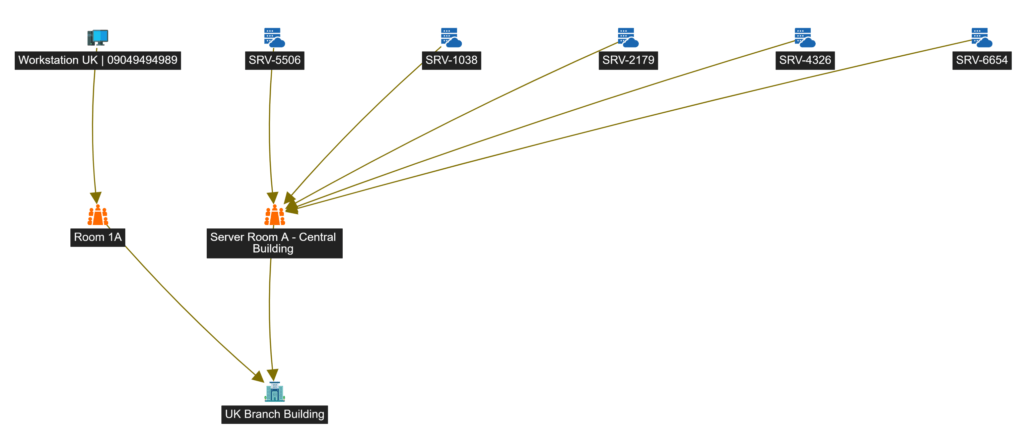5 reasons to map IT asset relations
Dependency mapping of IT assets is a key element to manage them. It provides an accurate map of the company's IT system, which includes hardware infrastructure, applications, and related dependencies.
What is IT system mapping?
Nowadays, all organizations have a range of systems, applications, and hardware devices, all interconnected. The structure is complex, but by effectively mapping dependencies between entities we have a clear picture of how they are interconnected and work together.
Dependency mapping of IT assets is a key element to manage them. It provides an accurate map of the company’s IT system, which includes hardware infrastructure, applications, and related dependencies. The map allows for a better understanding of the IT infrastructure, and it lets you identify the best actions to optimize IT operations.
To increase visibility, Deepser introduces the new Relations module that records and displays real-time relations between IT resources such as computers, network devices and other configuration items (CIs), including software licenses, workstations, locations, employees, groups, etc.
Deepser’s Relations module provides visual dependency maps of network topologies and virtual environments that are automatically generated. Thanks to the direct connection with the CMDB (Configuration Management Data Base) and IT Asset Manager modules of Deepser, the maps are updated in real time as the network changes and grows.
Deepser helps you get a complete view of the connections and relations between the elements that are part of your organization, not just those related to IT assets.
Which assets can we map?
All of them!
Deepser allows you to map all the entities present in the system.
You can therefore graphically display all the company’s physical and virtual assets, tickets connected to each of them, users assigned to various resources, contracts, locations, machinery and much more.
Let’s focus on IT dependency mapping, which is made up of three main components that provide a complete overview of the network. The components are hardware, software, and virtual resources.
By mapping the infrastructure and hardware you see the devices of the infrastructure and their relations. You can easily locate resources on the network identifying the interactions and impact they have on other devices. Servers, storage systems, networks, PCs, and tablets are just some of the assets to be mapped.
It is useful, or we should say essential, to map the applications, to see how software interacts with each other, where they are running and what resources they are using.
The virtual environment can be mapped to see the relations between resources, their grouping, and the status of virtual machines.
Finally, it is important to be able visualize the physical location of the assets: building -> floor -> room -> asset.
However, let’s not forget that for it to be complete and exhaustive, our map should include the people who are part of the organization and guarantee its functioning.

Why is dependency mapping useful?
To ensure business operations, it is essential to fully understand the size and configuration of the company’s IT system. With increasingly large and complex systems, which have a high number of interconnected assets, a single change can have consequences for the entire infrastructure.
In fact, only if we know which IT assets we have, we can protect them and guarantee their security, an essential condition for business continuity, as well as business service quality.
The absence of dependency mapping can in fact lead to operational inefficiencies, poor data quality, low levels of automation and communication problems both internally and with customers.
A “talking” map is a tool that provides a complete picture of the IT environment in real time. It can show us a specific asset, with all the relevant information, such as where it is located, what it is connected to, how it interacts with other assets, its history and much more, therefore providing a complete picture of the IT environment.
What benefits does Deepser dependency mapping offer?
- Clearer understanding of the IT system.
The map offers instantly more information about IT assets than a simple inventory list would. Above all, it makes relations with other entities in the system easily visible. - Complete control over dependencies.
The mapping clearly shows the interaction between assets. This allows you to identify the impact that any changes in the IT environment may have on certain assets, anticipating any service interruptions. - Better decision-making.
Thanks to Deepser’s visual map you can take more accurate decisions when planning infrastructure changes. Not only can you predict the impact of changes on other systems and applications, but you can also identify improvements that need to be made. - Reduction of intervention times.
It is crucial to provide quick responses when problems arise in the IT environment, to reduce downtime or poor performance. With a comprehensive network diagram, showing your entire IT system and its dependencies, you can easily pinpoint problems, their source and affected users. This allows you to take the necessary actions to resolve the problem and restore service quickly. - Lower costs associated with IT operations
Knowing the assets and how they are used allows you to optimize and improve their use and performance in the most efficient way possible before making new investments.
With Deepser you can identify underused or obsolete assets, evaluate their elimination or replacement with a more efficient and performing one. Removing obsolete assets saves many maintenance costs that could extend beyond the practical life of the asset.
You can start mapping right away!
Deepser automatically imports assets, products, software, users, and other elements from other tools in use. Other entities can be easily imported from CSV or Excel files, and you can keep them updated in the Deepser CMDB module. Clearly, you don’t have to manually enter each configuration element (CI).
Deepser Relations is fully integrated with Deepser CMDB software and the other module of our platform.
Activate a demo now or contact us for a free consultation.